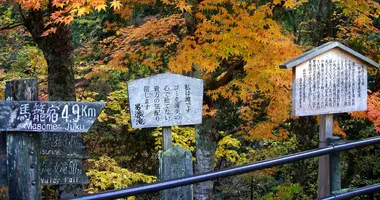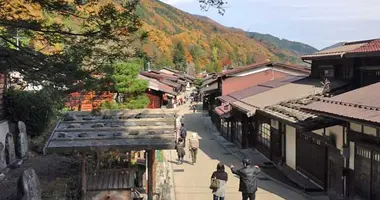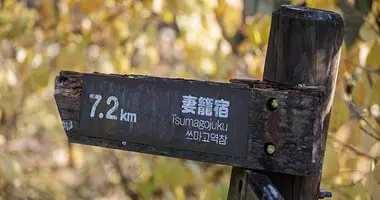Sado Island Guide 佐渡島
- Published on : 06/11/2020
- by : SR
- Youtube
The history of Sado Island, north of Nagano, is one of both a land of exile and the gold rush. Today, it is primarily a destination for seasoned hikers and a center of taiko drumming.
Sado Island
Sado-ga-shima ("Sado Island") is a sizable, S-shaped island lying off the coast, and part of Niigata prefecture. Sado is Japan's sixth largest island after Honshu, Hokkaido, Kyushu, Shikoku and Okinawa. Sado Island is made up of the mountain ranges of Osado and Kosado with the Kokunaka Plain sandwiched between them.
Historically, Sado was a place of exile, and important figures such as the Emperor Juntoku (1197-1242), Nichiren (1222-1282) the founder of Nichiren Buddhism, and Noh master Zeami Motokiyo (1363-1443) were exiled here. The influences these men brought with them into exile helped Sado Island develop and maintain its very own rich cultural and religious life incorporating puppet theater, okesa folk songs, ondeko drumming and demon dances, and Noh theater.
Sado has a relatively mild climate: warmer than mainland Niigata Prefecture in winter, with only about a quarter as much as the mainland's snowfall, and though still hot in summer, less so than on the Japan Sea coast. Sado therefore attracts visitors throughout the year to enjoy skiing, snowboarding, walking, cycling, hiking, swimming and diving.
Sado's biggest draw is the annual Earth Celebration hosted in August by the world famous taiko group, the Kodo Drummers.
Sado is also known for its gold mines, Sado Kinzan, in Aikawa, which have been mined since 1601, and helped to finance the Tokugawa shogunate.
Sado Attractions
Sado's main town and major point of entry is the port of Ryotsu on the east coast of the island, where the ferry and jetfoil from Niigata both dock. Ryotsu is also close to Sado's airport and makes a good base from which to explore the island. Ryotsu is convenient to hire a car, a bicycle or catch a bus out to Sado's many attractions. There are no trains on Sado.
Toki-no-Mori Park
The Toki-no-mori Koen (佐渡市トキの森公園 Toki Forest Park), just out of Ryotsu, is dedicated to a symbol of Sado, the Japanese Crested Ibis (toki), which became extinct on the island, but is being reintroduced with birds from China. Hours: 8.30am-5pm (last admission 4.30). Open every day March-November. Closed Mondays December-February (except when Monday falls on a national holiday, when it is open Monday and closed Tuesday). 383-2 Niibonagaune, Sado-shi.
Aikawa Town and the Kinzan Gold Mine
25 minutes' drive west from Ryotsu along national Highway 350 on Sado's central plain brings you to the western coast of Sawada (Sawata) facing Mano Bay. North of here is the town of Aikawa with its Sado Gold Mine and Museum. Sado Gold Mine was Japan's largest gold mine and was in operation from 1601 until 1989. At the peak of gold mining operations on Sado, Aikawa had a population of 100,000, more than the entire present population on the island.
During the Edo Period (1603-1867), Sado Gold Mine was under the direct control of the Tokugawa shogunate and the massive amounts of gold and silver mined here helped support the Tokugawa government. Visitors can enjoy a visit to either the Edo Period tunnels, the Meiji Period (1868-1912) tunnels or both.
Other places in Aikawa are the restored Sado Bugyosho, where the gold mining was administered and the old Kitazawa Flotation & Power Plants, an industrial relic that, in the 1930s, was the largest gold ore concentrator in East Asia.
The Aikawa Folk Museum & the Aikawa Exhibit House of Folk Crafts has more exhibits from Sado Gold Mine and hands-on pottery and sakiori weaving classes in the Exhibit House.
The Sado Hangamura Museum in Aikawa occupies an old court house and exhibits woodblock prints made by local Sado artists.
Sado Museums
Between Sawada and Mano on National Highway 350 is the Sado Museum with a comprehensive range of exhibits of the island's art, botany, crafts, geography and zoology.
Many of Sado's other museums are situated near the port town of Ogi on the south-west coast. These include the Sado-koku Ogi Folk Culture Museum (Sado Ogi Minzoku Hakubutsukan 佐渡国小木民俗博物館) with its replica of an 1858 wooden, sailing boat and various relics from Sado's past including clothing, tools and old photos. Close to Ogi and the Kodo Village is the Sado Island Taiko Center, where groups of five people or more can enjoy a hands-on taiko drum session.
The area of Shukunegi near Ogi was once a prosperous ship building center connected with the gold trade to Edo (present-day Tokyo). Now two wooden buildings are open to the public to demonstrate the boat-building techniques of the time. Nearby Shokoji Temple is dedicated to a deity offering protection at sea.
In Iwaya-san Cave, close to Ogi, are Buddhist images carved into the walls.
Sado Cultural Experiences: Noh Drama & Bunya Ningyo
Sado has more Noh stages per head of population than anywhere in Japan and Noh performances are held regularly from April to October. Some venues to see performances of Noh on Sado Island include Shiizaki Suwa Shrine, Myosenji Temple, Kanai Nohgakudo Hall and Daizen Shrine.
Bunya Ningyo is a type of puppet theater found only on Sado. The performances are accompanied by shamisen music.
Scenic Sado - the Osado Skyline
Sado has two mountain ranges, the Osado Mountain Range in the north of the island, and the Kosado Mountain Range in the south, with the inhabited Kokunaka Plain lying between them.
The Osado Skyline is a highway that traverses the western part of the northwards Osado mountain range and is a popular scenic route if you're driving on Sado Island. The highest point on the Osaka Skyline is 942m above sea level, offering grand views of the whole of Sado Island.
The Osado Skyline (Route 463) can be accessed from the main highway that runs across Sado Island, Route 350, at the Osado Skyline Iriguchi (Skyline Turn-Off) intersection in Kanai. On the other side, you will come to the Sado Gold Mine and Museum on the way down.
Bus tours of the Osado Skyline are also available from Niigata Kotsu Bus Co. Ltd.
Outdoors Sado
Tarai-bune Barrel Boats
No visit to Sado is complete without a ride in the island's distinctive tarai-bune, a wooden tub boat made from a barrel. Rides in tarai-bune are mainly to be had on the Ogi Peninsula: at Yajima (from the Yajima Experience Exchange Hall [Yajima Taiken Koryukan 矢島体験交流館]) and nearby Kyojima (経島), the latter having glass-bottomed boats.
The Ogi Diving Center offers the chance to see first-hand some of the weird and wonderful marine life that inhabits the waters of Sado.
Sado Mountains and Skiing
The highest mountain on Sado is Mount Kinpoku in the middle of the northwards Osado Mountain Range at 1,172 meters high. The Osado Range, with the higher mountains, is therefore more popular with hikers and mountaineers and, in winter, with skiers and snowboarders.
On the slopes of Mount Kinpoku and neighboring Mount Myoken, accessible via the Osado Skyline, are the Daira Ski Slope and Wonder Valley Snowpark Sado.
Daira Ski Slope
Daira Ski Slope includes a snowboard slope and has four courses: "Family," "Jet," "Utopia," and "Through the Woods." Daira Ski Slope is open from May to March, 9am-4pm, open Thu-Sun and on public holidays (in March, weekends and public holidays only). Closed during this season from December 28 to January 7. Ski and snowboard tuition is also available. Daira Ski Slope has parking for 130 cars (free parking).
- Access to Daira Ski Slope
Daira Ski Slope is about 50 minutes' drive from Ryotsu. The road near Daira Ski Field is controlled by the Japan Self Defense Forces, so on most days you will have to stop at some stage and use the roadside telephone to gain access. You must also use the roadside telephone at Daira Ski Slope to let the Self Defense Forces know when you are leaving. Tire chains required.
Wonder Valley Snowpark Sado
Wonder Valley Snowpark Sado is a ski and snowboard slope with four courses ranging between 300 and 1000 meters long. Wonder Valley Snowpark Sado is open from late December to early March, 9am-9pm. Especially towards the end of the season, it may not be open every day, so please telephone ahead to make sure. Ski and snowboard tuition is also available. In the summer months, horse riding, golf practice, and camping are also possible here. Wonder Valley Snowpark Sado has parking for 100 cars (no parking fee).
- Access to Wonder Valley Snowpark Sado
Wonder Valley Snowpark Sado is accessible by road, about 20 minutes from Ryotsu. Tire chains required.
Sado also plays host to the Sponichi Sado Long Ride cycling event in May and the Sado International Triathlon in September.
Sado Temples & Shrines
There are some beautiful temples and shrines on Sado, many of them in the settlement of Mano. One of the most famous is Myosenji (妙宣寺) a Nichiren Buddhist temple with an impressive five-story pagoda in the Abutsubo district, believed to have been built in 1278 by a devotee of Nichiren, Endo Tamemori.
Myoshoji (妙照寺) in the Ichinosawa district, also near Mano, was constructed in 1275 and is also associated with Nichiren. Myoshoji also has a five-story pagoda.
Jisshoji (御松山実相寺), about 500 meters south-east of Myoshoji, is also connected with Nichiren, and it was here at Jisshoji that Nichiren, the archetypal Japanese patriot, would daily worship the rising sun.
Konponji Temple (根本寺) is about halfway between Sawada and Ryotsu, in the Niiboono district, and was built in 1607. Konponji is dedicated to the life and work of Nichiren. The Konponji (also spelled Komponji) temple grounds contain a bell tower, a statue of Nichiren, and a pagoda. Admission is 300 yen.
Nearby is Chokokuji Temple (長谷寺) has rather obscure origins. The exiled Emperor Juntoku is said to have renamed the temple with the same kanji characters as Hasedera Temple in Nara or the Hasedera in Kamakura.
Seisuiji (清水寺), also in this vicinity, is written with the same kanji characters as Kyoto's more famous Kiyomizudera and is a copy of that famous temple.
Kokubunji Temple (国分寺) is the oldest temple on Sado and dates from 741. Kokubunji, located near Mano in the Kokubunji district, is possibly Sado's most beautiful and serene spiritual site. Restored some years ago to its former glory, Kokubunji has some beautiful thatched gates and a tranquility that will stay with you forever.
Rengebuji Temple (蓮華峰寺) is considered one of the three most important temples in esoteric Shingon Buddhism: the other two are Kongobuji in Wakayama and Murouji in Nara. Rengebuji is on the south-western Ogi Peninsula of Sado Island, and the present temple buildings there date from the 14th century.
Mano-gu (真野宮) is the tomb of the exiled Emperor Juntoku and is next door to the Sado Rekishi Densetsukan (Sado Historical Folklore Museum), where the late Charles R. Jenkins, a US army deserter married to a Japanese woman kidnapped from Sado by North Korean agents, worked as a greeter in the summer.
Sado Festivals
Sado Island has hundreds of festivals, large and small occurring throughout the year. The most well-known is the three-day Earth Celebration in August organized by the Kodo Drummers, which features musical performers from around the world, workshops, flea markets and arts exhibitions.
Sado's local festivals often include onidaiko drumming and okesa dance performances. Onidaiko, more usually referred to as ondeko, are drum performances accompanied by demon dances to drive out evil spirits. Each district in Sado has its own individual style.
Some notable festivals are the San-no-Matsuri at Hiyoshi Shrine in April, the Minato Matsuri in Ryotsu on May 5, the Yoi-no-mai Dance Parade in Aikawa in June, the Ryotsu Matsuri in mid June, the Ryotsu Tanabata Matsuri on August 7-8, the Shisigajo Matsuri in Sawada on August 11, the Ogi Minato Matsuri at the end of August, the Shimmachi Matsuri in Mano on October 16 and the Aikawa Festival on October 19.
Sado Food & Specialties
Sado's number one food attraction is its seafood. Memorably fresh, delicious fish is the norm on Sado, of a quality that would cost a great deal more to savor in the big cities. Almost any neighborhood sushi restaurant on Sado rivals the most exclusive Tokyo restaurants for freshness and flavor.
Sado is also known for its rice along with the rest of Niigata Prefecture, and also its sake. The Hokusetsu Sake Brewery (北雪酒造) in the south-western coastal town of Akadomari includes among its clients the internationally acclaimed Japanese chef Nobu and the actor Robert de Niro.
Specialties of Sado visitors may like to sample are its rice-crackers (sembei), sushi (available all over the island) and persimmons. Oysters (kaki), Japanese amberjack (kanburi) and squid (ika) are three types of seafood particularly associated with Sado.
Access - Getting to and from Sado-ga-shima
By Air
The main point of access from the main island of Honshu to Sado is from Niigata. There are 3-4 propeller flights a day (depending on season) from Niigata to the airport in Sado (SDO) near Ryotsu operated by New Japan Aviation Company. A local bus takes 15 minutes from Sado Airport into Ryotsu or 10 minutes by taxi.
Niigata Airport has flights from Osaka (Itami) (8 daily), Tokyo, Nagoya (both Komaki & Centrair), Sapporo, Hiroshima and Okinawa as well as Seoul (daily), Shanghai, Xian, Harbin, Guam, Khabarovsk, Irkutsk and Vladivostok.
By Ferry
From the ferry terminal in Niigata city there are two options to get to Ryotsu on Sado-ga-shima: the quicker, more expensive Jetfoil which takes 65 minutes (traveling at 80kph) or the slower, cheaper car ferry which does the journey in two hours and thirty minutes. Both boats are operated by Sado Kisen.
Niigata Ferry Terminal is reached by bus from Bay #5 of Niigata Bus Station or take a taxi from outside JR Niigata Station for around 1000 yen, which completes the journey in about 20 minutes depending on traffic.
There are also ferries to Sado from Terodomari in Niigata to Akadomari on Sado and from Naoetsu to Ogi on Sado.
Niigata is connected to Tokyo Station and Ueno Station by the Joetsu Shinkansen in two hours via the ski and onsen resort of Echigo Yuzawa. If you are coming from Osaka take either the Raicho train via Kanazawa to Naoetsu or Niigata or the quicker shinkansen route via Tokyo.
Getting Around Sado
Hiring a car or motorcycle is the best way to get around Sado, though the health-conscious may prefer a bicycle. Bicycles can be hired in Ryotsu, Ogi, Aikawa and Akadomari.
There are 16 fixed route bus lines and passengers can usually get on and get off without using a bus stop except on the busy Honsen Line between Ryotsu and Sawata. A weekend bus pass costs 2000 yen.


















